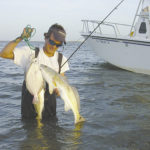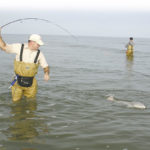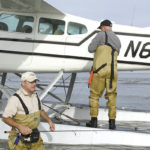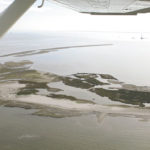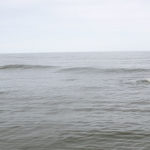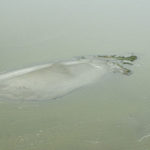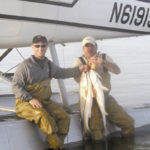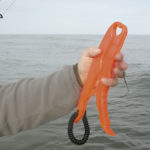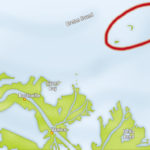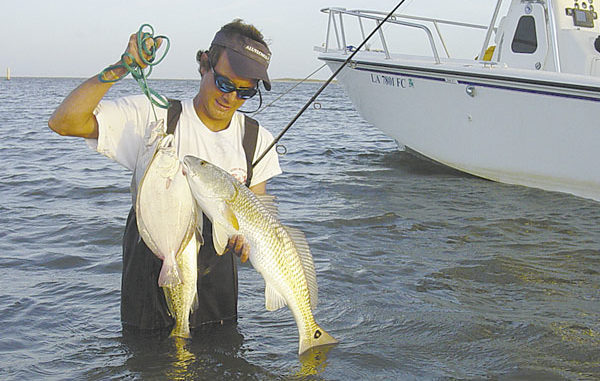
Don’t laugh. Get out there this month, and you’ll find ridiculously large schools of ridiculously large redfish in ridiculously clear water.
Minutes after surveying Breton Island’s surprising paucity of fish and off-colored water, Gibby Andry, Lyle Panepinto and I were passing over the solemn remains of what is left of Grand Gosier Island. A small spit of land and a series of sandbars and shallow flats offer a grim reminder of what once was a land mass significant enough to put on most state maps.Andry commented briefly of the state of the island — a mere 31 minutes from take-off in Belle Chasse complete with a grave survey of the Caernarvon marsh wracked by the latest series of hurricanes — then returned to laser focus on guiding the plane on its mission: find redfish, and lots of them.
“Generally, when the trout move out, the reds move in,” he said. “The wintertime is my favorite out here. When you get a high-pressure system over the area, a falling tide and a relatively low Mississippi River, that’s when you need to be out here.”
Panepinto, owner of Southern Seaplanes in Belle Chasse, had somehow put the headaches of running the business behind him for an afternoon and joined us. He was the first to spot the solid school of fish as we made a pass over the eastern end of what’s left of the island.
Almost frenzied chatter over the earphones rang out as two grown men remarked on the size of the fish and the incredible numbers evident from over 500 feet out.
“There, right there over that bump,” said Panepinto, referring to a small sandbar on the island’s Gulf side. “That’s a nice group of fish. We’ll swing back around and try and get a few shots of them. Did you see them, John?”
I had, but had not been able to drink in the sheer ecstasy of a massive school of fish finning in crystal-clear water. My stomach churned, not because of the deft aerial maneuvering by Andry, but because I knew these guys were serious about moving past the nonsense of getting me shots from the air and into the task of having one of the bronze brutes stretch their line.
Seconds after spying the fish, Andry was banking hard in an effort to get me in position for photos of the school from above. Panepinto locked onto the school by keeping an eye on a slight incongruity on the beach, straining his neck so as not to lose his perspective on the mainly featureless island.
Inexperience with the camera’s settings prevented anything in focus, much less usable, though Andry had another theory.
“Simple’s better out here. The best thing I’ve used is one of those disposable cameras,” said Andry as he lined up on the island’s backside for a landing.
Once the plane was secure, Andry went about discussing the finer points of tackling redfish in the Breton chain’s surf as Panepinto hustled off to find the school. Topics such as the virtues of single-hook gold spoons, spinning gear to combat the ravages of a certain dunking in the salty surf and the strong suggestion of fashioning the spoon to the line with a heavy-duty snap swivel.
“And even that doesn’t hold them sometimes. These fish out here in the Gulf are different. They’re really tough,” said Andry.
We waded out, trading stories about the last time I was out here before Hurricane Katrina, when the western end of Breton Island was a thriving pelican rookery. Now, sadly, there’s almost nothing left.
“It’s a shame,” Andry said. “There’s a little bit of evidence that the land has shifted around and is building, but we’ve lost a whole bunch of land. It’s just storm after storm out here. There’s no time to recover.”
Panepinto was the first to get on the board with a nice 20-pounder, but the school that had literally lit up our line of sight from above had eluded us so far.
“That’s what’s weird about today,” Andry said. “Usually the fish will, for the most part, stay in one place. I could tell after the second pass up there that they were on the move. We’ve gotta keep looking. They’ll be back.”
Ten minutes later, Andry proved correct. A school of redfish humped up out of nowhere — their hanging out in deeper than usual water on the beach side had hidden their presence — and now the beauty of a school of at least 300 fish was in plain view for all to see.
Andry was virtually on top of the school, so a quick cast resulted in an immediate hook-up. I, on the other hand, had just made a long cast in the opposite direction. The lure landed just as Andry remarked as to the size and proximity of the school. I concurrently cringed, chuckled and hoped for the best as a pod of the obviously actively feeding redfish charged Andry in water than was just over waist deep.
At the same time, I was reeling in my spoon — the 1/2-ounce model couldn’t have been more perfect for prospecting the long stretches of open water — as fast as I could in order to get in on the action. Time stood still as I watched two dozen bronze warriors milling about 50 feet away. Somehow managing to fire a cast to the fish while avoiding a backlash, I was rewarded by coming tight with a lean 32-incher, as much fish as I wanted to tackle later on at the cleaning table.
The strong first run of my fish thankfully shooed away the blunt-nosed troublemakers from belt level.
“That’s what we’re looking for,” said Andry as he worked on unhooking his fish and I snapped pictures and somehow managed to control a fish that was now at least 100 yards away in the clean green surf. “It really is amazing out here this time of year. Believe it or not, this is what we consider dirty water. Most of the days we make it out here, you can see every detail of a fish that’s close.”
Enjoying the wondrous, if fleeting, aesthetics of the lower Chandeleur chain from a boater’s perspective is Raymond McKenzie. The offshore supervisor, who has unsuccessfully sought and angled for jobs requiring helicopter trips to rigs that pass over Breton Island, has successfully parlayed his seven on/seven off job into a fishing career rich in Breton/Gosier Island success.
The long blocks of time off, parlayed with an understanding spouse and a child long since out of the house, gives McKenzie opportunity to frequently realize the fruits of wading the island chain’s beaches and flats for ravenous schools of redfish during the winter months.
“It’s just an awesome experience when you hit it right,” he said. “Even now when you’ve got less pressure on the islands during the summer, when you pull up to them and there’s no one else around, it feels like the final frontier or something. I end up spending a lot of down time looking at the weather forecast, trying to gauge when a front’s going to come through right and the winds lay down enough to get out there.”
Never having been terribly interested in the fashionable ubiquitous bay boats of modern times, McKenzie caught a sweet deal on a 24-foot Grady White about 10 years ago, a rig with twin engines to put his mind at ease when making often solo trips out of Venice.
“I enjoy wade fishing, and really think those Texas guys have the right idea,” he said. “I notice it in the summer when the bay boats run out here and start buzzing around with those trolling motors. And that’s why I like my schedule and doing overnight trips. Super early mornings and afternoons are when the fishing gets good again, especially for trout.”
Not having the capability of a quick bird’s eye view that pilots have, McKenzie sticks to the tried-and-true method of prospecting for fish — a quick sweep of the beach to get an idea of what’s what since his last trip. Though finding new sandbars and troughs isn’t nearly as important as it is in summertime trout fishing — island redfish are notoriously nomadic roamers, cruising up and down the beach and backside flats in search of the baitfish buffet table — they do give anglers like McKenzie an idea of where the schools might be traveling.
“It’s not often that I can’t find a good pod or two of fish to work in between Breton and Gosier, but every now and then, they’re not making themselves visible when I pull up,” he said. “That’s generally when they’re looking. The bait generally stays as close to the beach as they can without messing up their ability to move in however big of a school they’re traveling in.
“Knowing where the guts and bars are positioned — and sometimes it’s hard when you catch a really calm day out there — can give you a good place to start.
“These schools this time of year have got one thing and one thing only on their mind: food. They’re done spawning, and they’ve got to survive out here in the Gulf. When the water calms and they can zero in on a school of baitfish, they take whatever they can get right then.
“I’ve got some friends who fish for these big fish on the inside, and they’re always telling me about these days they have when they see this many fish and had this many shots at them and sometimes they don’t have a strike all day. It seems that these fish don’t have a choice about being snooty. For whatever reason, they’re out in the Gulf instead of up in the marsh, where I’ve got to think it’s easier living. When they get a chance to eat, they take it.”
McKenzie doesn’t go for the long slugfests many anglers savor in tangling with redfish that can approach 50 pounds. It’s not that he’s all that altruistic — he never fails in keeping one of the brutes and devoting 20 minutes or so to cleaning it and making several batches of courtbouillion with the dense cubes from the loins. The staggering numbers of fish at the islands trigger the competitive instinct in him.
“My record is 53 fish over 30 inches, and the heavy tackle helps me get these fish in in a hurry so that I can get that bait back out there,” said McKenzie. “Now, there’s also the fact that you don’t want to tire these fish out too much, but there’s not near as many sharks out here as in the summer, and I can’t believe that they build up as much lactic acid as they do when it’s hot.”
His coldwater season arsenal borders on that used in today’s advanced bottom fishing. A heavy-action 7-foot rod matched with an old Ambassador 6500 loaded with as much 80-pound Spiderwire — his current choice in the musical chairs game many braided line devotees play — as he can pack onto the spool. A 50-pound fluorocarbon — which is used solely for its abrasion-resistance — leader connected with a small barrel swivel. A 1/2-ounce unpainted jighead and H&H queen Cocahoe tail completes the set-up. The color is unimportant as long as the soft plastic tail lacks one thing.
“One thing I really think is important that not many people realize is to pick a bait without any kind of chartreuse or pink whatsoever,” he said. “These fish are so competitive and hungry that if they see something hanging out of another’s mouth, they’ll try and steal it. Just like when a gull picks up a scrap at the fish-cleaning table that’s a little too big — he’s gonna have a whole lot of company.
“When a redfish tries to steal a bait out of another’s mouth, a whole lot can go wrong. The hook can get popped out, a gill plate from the other fish can scrape the leader or the line, whatever. All of it’s bad, though. It’s fun to watch a half dozen fish bird-dogging the fish you’ve hooked right up until the time that fish gets off.”
Bird’s eye view or not, few things parallel the final-frontier quality of the Breton Island chain between cold fronts.
